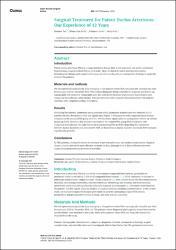| dc.contributor.author | Tort, Mehmet | |
| dc.contributor.author | Ceviz, Münacettin | |
| dc.contributor.author | Sevil, Fehim Can | |
| dc.contributor.author | Becit, Necip | |
| dc.date.accessioned | 2022-05-27T08:32:24Z | |
| dc.date.available | 2022-05-27T08:32:24Z | |
| dc.date.issued | 28.04.2021 | en_US |
| dc.identifier.citation | Tort, M., Ceviz, M., Sevil, F., & Becit, N. (2021). Surgical Treatment for Patent Ductus Arteriosus: Our Experience of 12 Years. Cureus, 13(4). | en_US |
| dc.identifier.issn | 2168-8184 | |
| dc.identifier.uri | https://doi.org/10.7759/cureus.14731 | |
| dc.identifier.uri | https://hdl.handle.net/20.500.12933/1104 | |
| dc.description.abstract | Introduction
Patent ductus arteriosus (PDA) is a congenital heart disease that, if left untreated, can lead to pulmonary hypertension, congestive heart failure, and death. Here, we aimed to assess postoperative cardiac hemodynamic changes and surgical techniques, as well as early and late postoperative findings in surgically treated PDA patients.
Materials and methods
We retrospectively analyzed the data belonging to 126 patients whose PDA was surgically closed in our clinic from January 2001 to December 2012. With echocardiography being a standard in diagnosis and follow-up, angiography and computed tomography were also used in the presence of pulmonary hypertension and congenital heart disease, when needed. Postoperative data were compared between isolated PDA patients and those with congenital cardiac deformities.
Results
Evaluating the patients' pulmonary artery pressure (PAP), pulmonary hypertension was detected in 121 patients (96.0%). Preoperative PAP was significantly higher in PDA patients with congenital heart disease compared to the isolated PDA group (p<0.05). PAP decreased significantly in postoperative follow-up in both groups (p<0.05). However, this decrease was faster in the isolated PDA group than in patients with congenital heart disease and right-left shunt accompanying PDA (p<0.05). Regarding the correlation between ductus diameters and preoperative PAP, we found that as ductus diameter increased, PAP increased significantly (p<0.05).
Conclusions
In PDA patients, closing the ductus is necessary to prevent pulmonary and cardiac complications. Surgical closure remains one of the most effective methods for this, although there is little difference between surgical treatment methods in terms of mortality. | en_US |
| dc.language.iso | eng | en_US |
| dc.publisher | CUREUS INC | en_US |
| dc.relation.isversionof | 10.7759/cureus.14731 | en_US |
| dc.rights | info:eu-repo/semantics/openAccess | en_US |
| dc.subject | Pda | en_US |
| dc.subject | Patent ductus arteriosus | en_US |
| dc.subject | Pulmonary hypertension | en_US |
| dc.subject | Surgical closure | en_US |
| dc.subject | Ligation of pda | en_US |
| dc.title | Surgical Treatment for Patent Ductus Arteriosus: Our Experience of 12 Years | en_US |
| dc.type | article | en_US |
| dc.authorid | 0000-0003-3902-9831 | en_US |
| dc.authorid | 0000-0002-9086-515X | en_US |
| dc.department | AFSÜ, Tıp Fakültesi, Cerrahi Tıp Bilimleri Bölümü, Kalp ve Damar Cerrahisi Ana Bilim Dalı | en_US |
| dc.contributor.institutionauthor | Sevil, Fehim Can | |
| dc.contributor.institutionauthor | Becit, Necip | |
| dc.identifier.volume | 13 | en_US |
| dc.identifier.issue | 4 | en_US |
| dc.identifier.startpage | 1 | en_US |
| dc.identifier.endpage | 9 | en_US |
| dc.relation.journal | Cureus | en_US |
| dc.relation.publicationcategory | Makale - Uluslararası Hakemli Dergi - Kurum Öğretim Elemanı | en_US |
















